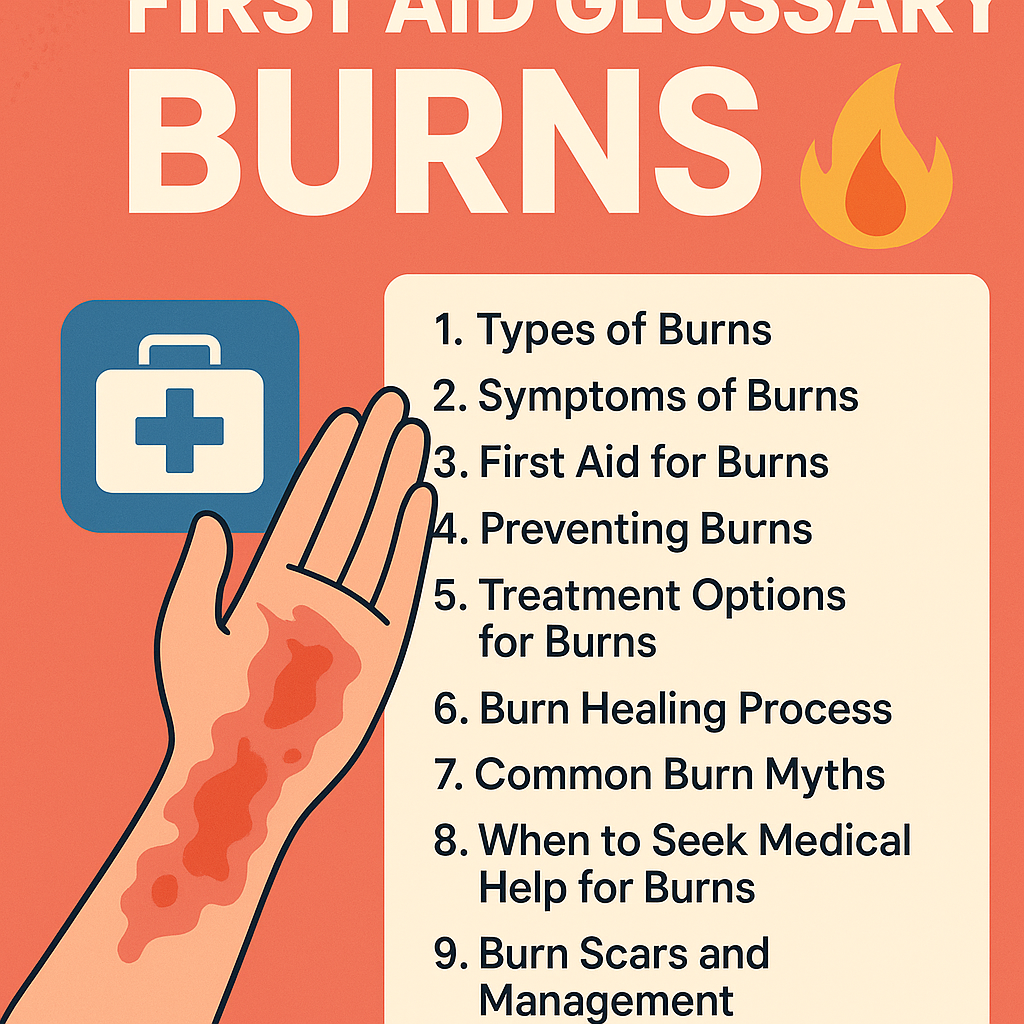- Types of Burns
- Why This Matters
- Symptoms of Burns
- Key Symptoms to Monitor
- First Aid for Burns
- Trainer Tips
- Preventing Burns
- Safety Advice
- Treatment Options for Burns
- Best Practices
- Burn Healing Process
- Signs of Healing
- Common Burn Myths
- When to Seek Medical Help for Burns
- Burn Scars and Management
- Motivational Note
- Resources for Burn Survivors
- Call to Action
Glossary: Burns Definition
Burns are injuries to the skin or other tissues caused by heat, chemicals, electricity, radiation, or friction. Understanding burns—how they occur and how to treat them—is crucial for effective first aid and can make a significant difference in recovery outcomes.
—
Types of Burns
Burns can be categorized into several types based on their causes and severity:
1. Thermal Burns: Caused by contact with flames, hot liquids, steam, or hot objects.
2. Chemical Burns: Result from exposure to harsh chemicals, such as acids or alkalis.
3. Electrical Burns: Occur when electricity passes through the body; serious due to potential internal damage.
4. Radiation Burns: Often caused by sunburn or exposure to radiation from medical treatments or sun exposure.
5. Friction Burns: Caused by the skin rubbing against a rough surface, akin to a carpet burn.
Why This Matters
Recognizing the type of burn helps determine the appropriate first aid response. Each type has unique characteristics and treatments.
—
Symptoms of Burns
![Generate a high-quality, realistic 4K image illustrating [TOPIC]. Each image should have a slightly](https://firstaidglossary.com.au/wp-content/uploads/2025/10/generate-a-high-quality-realistic-4k-image-illust-1760691007.png)
Various symptoms indicate the severity and type of burn. Recognizing them early can lead to better treatment:
– First-Degree Burns: Redness, minor swelling, and pain without blisters (think of a sunburn).
– Second-Degree Burns: Redness, blisters, and severe pain. The skin may appear wet or shiny.
– Third-Degree Burns: White, charred skin that may be numb (the nerve endings are damaged).
– Fourth-Degree Burns: Extends beyond skin into muscles or bones, often resulting in extensive tissue damage.
Key Symptoms to Monitor
– Redness and swelling
– Blisters or open wounds
– Pain level (keep in mind: more severe burns can sometimes be less painful due to nerve damage)
—
First Aid for Burns
If you encounter a burn, it’s helpful to know immediate first aid steps:
1. Stop the Burning Process:
– For thermal burns, remove the source of heat if safe to do so (e.g., extinguish flames).
– For chemical burns, flush the area with cool water for at least 20 minutes.
2. Cool the Burn:
– Use cool (not cold) running water for 10–20 minutes to reduce temperature and pain.
– Avoid ice, as it may worsen damage.
3. Cover the Burn:
– Use a clean, non-stick bandage.
– Avoid using cotton or fluffy materials that may stick to the burn.
4. Monitor for Symptoms:
– Watch for signs of infection, pain levels, and changes in the condition of the burn.
Trainer Tips
– Don’t Pop Blisters: They help protect the underlying skin.
– Stay Calm: Reassure the person affected; staying calm can significantly reduce anxiety.
—
Preventing Burns
![Generate a high-quality, realistic 4K image illustrating [TOPIC]. Each image should have a slightly](https://firstaidglossary.com.au/wp-content/uploads/2025/10/generate-a-high-quality-realistic-4k-image-illust-1760691057.png)
Prevention is always better than treatment. Here are some practical tips:
– In the Kitchen: Always use oven mitts and be mindful of hot surfaces.
– In the Bathroom: Test the water temperature before stepping in.
– Outdoors: Wear sunscreen and protective clothing to guard against sunburn.
Safety Advice
– Teach children about fire and safety.
– Have a fire extinguisher nearby in your kitchen.
—
Treatment Options for Burns
Understanding treatment options can empower you to make informed decisions:
– For Minor Burns: Over-the-counter pain relief and antiseptic ointments may suffice.
– For Severe Burns: Medical intervention is necessary. Treatment may involve surgery, skin grafts, or specialized burn care centers.
Best Practices
– Don’t apply butter or oils—these can trap heat and worsen the injury.
– Seek immediate medical help for third or fourth-degree burns.
—
Burn Healing Process
The body has an incredible ability to heal, but the healing journey varies based on the burn type:
1. Minor Burns: Typically heal within 1–2 weeks.
2. Severe Burns: Healing can take much longer and may require medical interventions.
Signs of Healing
– Decreased pain
– Marked reduction in redness and swelling
– New skin formation
—
Common Burn Myths
Understanding the truths about burns can improve reaction and recovery:
– Myth: “You should use ice on burns.”
Fact: Ice can cause further damage. Stick with cool water.
– Myth: “A burn that blisters needs to be broken.”
Fact: Keeping blisters intact aids the healing process.
—
When to Seek Medical Help for Burns
It’s crucial to know when a burn exceeds home care capabilities. Seek professional help if:
– The burn is larger than 3 inches.
– It involves the face, hands, feet, genitals, or major joints.
– It’s a third or fourth-degree burn.
– Symptoms of infection (such as increased redness and pus) occur.
—
Burn Scars and Management
Healing may also involve dealing with potential scars. Here’s what to consider:
– Types of Scars: Can range from pigmented scars to keloids.
– Management Techniques: Silicone gel sheets, massage therapy, and sometimes laser treatments.
Motivational Note
Every burn survivor’s journey is unique. With the right care and support, significant recovery and healing can occur.
—
Resources for Burn Survivors
Connecting with the right support can be vital:
– Burn Support Organizations: Look for local or national burn associations.
– Community Groups: Patient support groups can offer shared recovery experiences and emotional support.
Call to Action
Remember, being prepared can make all the difference. Knowledge is power—invest in learning about burns and first aid today. You’ve got this! Whether it’s understanding prevention, symptoms, or treatment, your readiness can save a life—and that’s heroic.
Keep learning, stay confident, and empower yourself to act decisively in an emergency.

Leave a Reply